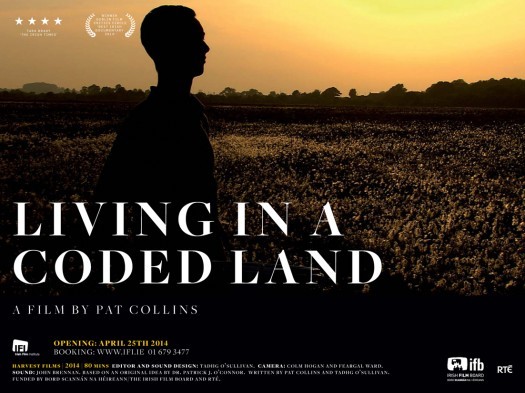[quote]The past is never dead. It is not even past.[/quote]”
Faulkner Requiem for a Nun (1950)
This line, uttered in the film by the poet Peter Fallon perhaps neatly sums up the preoccupations of Pat Collins in his new film Living in a Coded Land. But perhaps not. Collins goes back to the filmic essay, creating a unified document that questions whether we ever really learn as a people. The film makes elusive links between past and present, emigration, politics, war, religion and land ownership and drapes them over a country in crisis. After the relative success of his first feature film Silence in 2012, Collins would be forgiven if he had tried to capitalise on it with another feature. But Collins as a filmmaker is looking to dig deeper. In his previous film Silence the main character Eoghan burrows into the soil of his abandoned country like he is formed by it. And like of all of us, he is. Ireland is a country with historical heft and its sons and daughters are shackled with that history from birth. If Collins was saying in Silence that we needed to touch the soil to feel connect to it, in Living in a Coded Land he seems to be suggesting that as a people we are enslaved to it. We bow down to a ruling class like we have done for centuries; suffering in silence. There is a lot of anger here, beneath the deceptively peaceful shots of the midlands, the literal heart of the country.
The film begins, tellingly, with a pub scene. There are people of all ages in a country pub and there is plenty of music and dance. Particularly noticeable are a lot of younger women dancing. This could well be at the beginning of the journey of Ireland’s women to become something more than second class citizens (a fight that continues today). Dancing, so synonymous with sexuality according to the Catholic Church for many years, is here shown as a communal and enjoyable experience. But there are clouds. The picture of the Virgin Mary on the pub wall looks down on events with an (imagined?) look of disapproval. The wonderfully evocative and music by Aine O’Dwyer kicks in and we settle down for a lesson in history, politics and finance.
Collins has a great eye for the juxtaposition. He cuts between archive footage and newly shot scenes to great effect. There is some old footage of an imposing church cut with shots of old village buildings for sale. There is a shot of a nun walking alone on a deathly quiet street that is juxtaposed with children playing on a street with abandon. More obvious but very effective is a voiceover talking about 18th century landowners over shots of a country fair with AIB mortgage advertisements adorning the area. This is clever and dryly humorous but with a savage edge. There are others that will become more obvious on future re-watches. And Living in a Coded Land does not simplify anything. There is a depth and understanding of the cause and affect of history and how certain events seem destined to play out.
There has been plenty of column inches given over to how Calvary is a study of the Irish psyche that has arrived at just the right time to take our collective temperature. But that film scratches the surface and in reality, offers no real insight as to who we are now and why. This is the real deal. There are two extraordinarily moving passages in Living in a Coded Land that illustrate how what is happening to our country now and, more importantly, the segments are historical. The first is a reading of poet Michael Hartnett’s Inchicore Hiaku which is recited across extraordinary black and white footage of a derelict Inchicore. Indeed a derelict Dublin bereft of the future wealth we gained and lost in the blink of an eye. But it is worse than derelict, it looks like war footage after the blitz. There is also a very moving archive interview from John B. Keane who describes being on the ferry to the UK in the early 1950s with men who were emigrating to find work. He speaks with a compassion and heartbreaking love of their decency that puts our current government to shame. These are just two examples in the film where history seems to violently crash into our difficult modern world. This linkage is important. Living in a Coded Land suggests a bleak future for our country. There is despair and, to this reviewers mind, only a small bit of hope.
The technical achievement of this film is superb. The archive footage is excellent and more importantly excellently deployed. This is down to the superb editing by Tadhg O’Sullivan. It allows the film to flow. The musical pieces throughout by Áine O’Dwyer and Linda Buckley are terrific and a beautiful layer to the film. If you were to be picky the film lags a little for about 30 minutes in the middle but yet is never dull. Having read descriptions of Pat Collins’ work as slow cinema there is a feeling that this could be construed as a little bit of an insult. The description we should be reaching for is great cinema. Living in a Coded Land is a chilling and necessary document; one that could, and indeed should, be digested by all. One of the films of the year so far.

